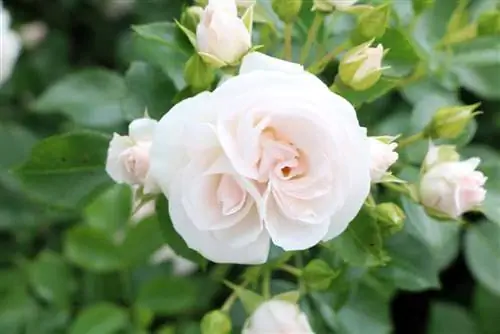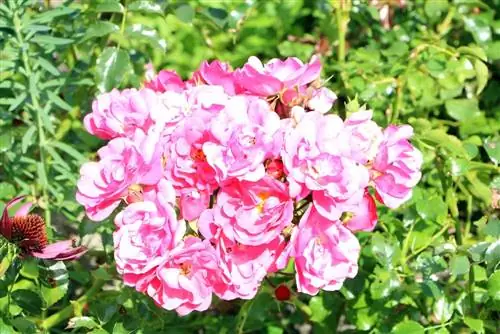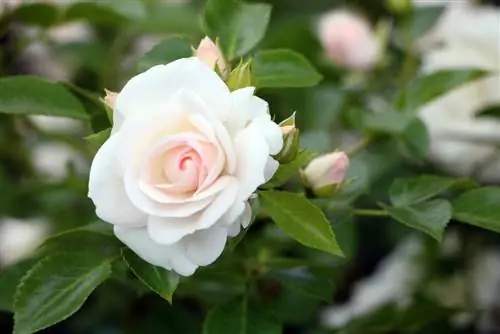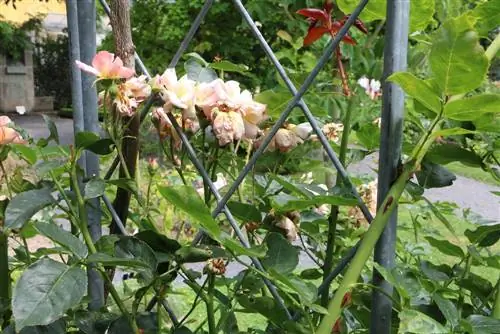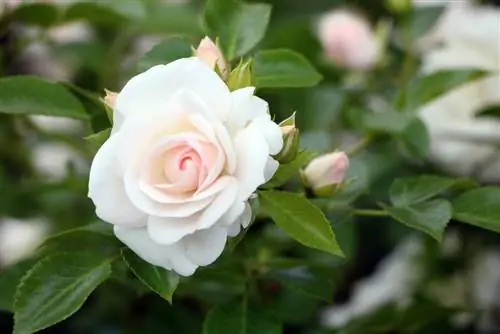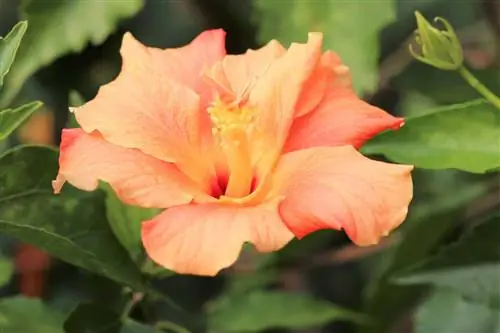- Author admin [email protected].
- Public 2023-12-17 03:39.
- Last modified 2025-01-24 12:45.
Mini roses are bred specifically for use in pots. In general, you can plant any variety in a pot; the growth habit and care are crucial for long-term prosperity. Mini roses prefer a sunny location, but are grateful for shade at midday.
Not all miniature roses are the same
Many roses are sold as minis, but there are differences. The miniature roses that are offered so cheaply in stores are pot roses, i.e. made for the flower pot. They are simply cuttings that have been stuck into the ground. Otherwise, roses are refined. That also makes them more expensive. Miniature roses are therefore not placed on a resistant base on which they can develop further. So they have no support and are therefore very susceptible to bacteria and fungal diseases. Powdery mildew is widespread. This also means that these small roses are not hardy.
Patio roses are a bit larger and also more robust. They are suitable for patio beds and planters and also survive the winter outdoors quite well. A very radical cut promotes the roses' willingness to bloom. Patio roses are not houseplants
Miniature or dwarf roses?
Miniature roses are even smaller in growth than dwarf roses. They also have smaller leaves and flowers. However, both varieties are also offered under the different names. There is not always clarity. You can only find clarity on the variety labels. It should say how big the plants can get.
Laur rose breeders are short, compact varieties of dwarf or patio roses. They can be planted in the garden or used in pots. Miniature roses are the very small roses. They are often chemically compressed during production, i.e. kept artificially small (growth inhibitors). Miniature roses are a proprietary breed, especially small, compact varieties. They are used for windowsills or balconies and are generally not suitable for outdoor use.
Further care instructions
It is recommended to use a tall plant pot so that the fine, deep hairy roots of the mini rose have enough space. In order for them to develop well, you should water less often but thoroughly. To ensure that the root ball is evenly moistened, the rose can be placed in a water bath every now and then for 10 to 15 minutes. If the plant pot offers enough space, you can plant rose cavaliers such as sage or catnip.
Withered flowers should be cut off regularly so that the mini rose does not have to put any energy into producing seeds. In this way, the growth of flowers is encouraged. Creating a drainage system ensures good water drainage. To do this, fill in about three centimeters of chippings or expanded concrete. The watering edge of 2 to 3 centimeters above the pot is very important. It should definitely remain so that the rose can be watered lavishly. The mini rose should be planted deep in the pot, with the grafting area approximately 5 centimeters below the ground. Immediately after planting, water the mini rose vigorously, but do not wash away the loose soil. The variety of mini roses can be used to design your balcony, garden, terrace or in your home. The Sweet Haze is a delicately scented mini rose in pastel colors.
Conclusion
When caring for miniature roses, you really need to know what type they are. Dwarf and patio roses can be planted out and cared for just like any other roses. The miniature roses, which are simply cuttings, require slightly different care. A good location is important. It should be bright and warm, but not too warm. Full sun is unfavorable. It is often better to plant them in a slightly larger pot, even if this initially comes at the expense of new flowers. It is poured very carefully. Too much moisture kills the small plants. Always wait until the soil has dried thoroughly before watering. Then it is poured thoroughly. Drain off excess water. It is better to wait until the rose shoots hang a little limply and only then water them than to keep the soil always wet. As soon as the rose receives water, it stands up again. Fertilizing is also good, it gives the rose strength.

